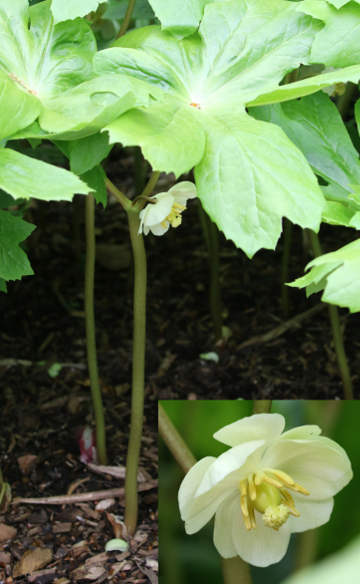Village News

PHOTO COURTESY OF GARRY KESSLER
Mayapple plant and blossom (inset).
June7, 2019, Page A8
NATURE NOTES
By Annie Reid
Westborough Community Land Trust
Mayapple: a rare May wildflower
Our May-June woods hold many wildflower treasures, sometimes even a rare one known as mayapple. Look for plants with two large umbrella-like leaves that shelter a bud that becomes a waxy white flower.
The plant is called mayapple (Podophyllum peltatum) because it blooms in May, has a blossom that might remind you of a large apple blossom, and makes a fleshy fruit that looks somewhat like an apple or lemon. You might notice the fruit in the final month of summer, as the large leaves die back. The leaves have 5-7 deeply cut lobes.
Is mayapple a native wildflower? That depends. What does it mean for a plant or animal to be native? Usually, “native” means that a plant or animal occurs naturally in an area, and this is taken to mean that it was present there when European settlers arrived. In New England back then, mayapple was found – and well known to native Americans – in western parts of Massachusetts, Connecticut, and Vermont (and farther west and south), but not here in eastern Massachusetts. European settlers learned about mayapple from native Americans and introduced the plant into their own gardens in our area. Colonists often called it mandrake, because its root looked similar to the root of a different plant, the mandrake (Mandragon officinarum) they knew from Europe.
All parts of the mayapple plant are toxic, so why were early settlers interested in it? The plant had medicinal and other uses. Settlers found out about these from native Americans. Extracts of the root were used as a powerful laxative, as a treatment for worms, as a medicine for rheumatism, and as an ingredient in tonics. Techniques such as drying, roasting, and boiling were used, often in combination, to make the root less toxic. Some native American groups made an insecticide from the plant and used it to kill pests on their potato and corn crops. In recent years, a chemical called podophyllotoxin from the root has been found to interfere with cell division and has been used in treatments for some kinds of cancer.
What about the “apple” in mayapple? It too is toxic, except for the flesh of the ripe fruit. A favorite old-time use was to make a jelly from the fruit, which becomes yellowish wrinkly when ripe. The skin and seeds remain toxic and were not used. Wildlife such as grackles, mice, squirrels, and eastern box turtles feed on the fruit.
Where are you likely to spot mayapple these days? Look for this rare plant if you visit protected areas such as conservation areas, historical areas, and wildflower gardens. Gilmore Pond and the Walkup & Robinson Reservation in Westborough, and Garden in the Woods in Framingham, are such places. The plant can spread underground, so large colonies can become established and last for decades in protected places. Bumblebees and solitary bees pollinate the flowers, which produce pollen but not nectar.
If you see this wildflower, enjoy its beauty and let it remind you of a bit of the history of our area.